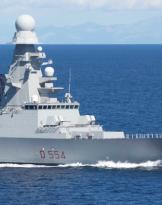The now venerable F / A-18 Legacy Hornets it was transformed into a 4.5 generation fighter aircraft, as well as other fourth generation cells, designed on the basis of the doctrines of the 70s, were subsequently remodeled, reconfigured and re-equipped to face the missions of the XNUMXst century.
Il Super Hornet, compared to previous versions of the F / A 18, has a 25% larger wing and 35% more power thanks to General Electric F414moreover, always unlike the Legacy, can place on an aircraft carrier with all the war cargo still (bringback) allowing far greater flexibility in mission planning.
From a fiscal point of view, thanks to the costs of scale due to over six hundred Super Hornet ordered by the US Navy, individual specimens cost the taxpayer less than $ 70 million; in fact, in April 2020, Boeing had delivered 608 aircraft to USNavy, consolidating the role of Super Hornet like "Backbone of the fleet". Meanwhile, the F-35C embarked version of the Joint Strike Fighter of Lockheed Martin which was originally priced at around $ 109 million, the cost per unit was reportedly reduced to $ 94,4 million. The Lightning IIAlthough it has reached initial operational capability, it still has yet to qualify for combat to tackle its first operational cruise in 2021.
It is noted that the difference in the initial purchase cost between these two aircraft appears to be almost contained compared to the gap in operating costs; fuel, maintenance and other expenses calculated on an hourly flight basis cost approximately $ 35.000 / h for the F-35C fleet against approximately $ 10.500 for superhornt.

The US Navy has invested significant resources to improve the production line of the Boeing facilities in St. Louis dedicated to the program Super Hornet over the past three decades. The latest moves of this strategy, in fact, were aimed at promoting the launch of the F / A-18E / F Super Hornet Block III.
Despite its intentions to equip itself with a fleet of 273 35th generation F-79Cs, the US Navy still has XNUMX brand new Super Hornet in the order book, even if, as written in a previous article, the Senate is considering cutting the order to finance the study of a new sixth generation aircraft.
Il Super Hornet Block III is now being tested at Naval Air Station Patuxent River, Maryland, which boasts some significant improvements over its immediate predecessors, plus all Block II they will be updated to a configuration block III complete or partial.
Il Block III comes with Raytheon radar APG-79, already introduced on Block II, as well as a new processor (Distributed Targeting Processor-Networked) and an advanced data link (Tactical Targeting Network Technology).
These improvements allow the new Super Hornet to transmit and receive huge amounts of data, which means that it will be able to receive information from distant opponent targets and ground targets without activating its own radar, the ignition of which would reveal their position, and moreover it will be able to share the data your radar collects with platforms stealth closer to the targets. The integration of the latest infrared search-and-track pod (Lockheed-Martin IRST21) will offer to Super Hornet greater ability to strike in stand-off mode. These pods can detect their targets remotely, via the heat emissions from airplanes, and thus allow the radar to remain off while it pursues its target.
 The new Super Hornet they will also be equipped with 10 x 19-inch digital schemes (Advanced Cockpit System) that will make it possible to simplify operations for the pilot and perhaps - most importantly - an extension of the duration of the airframe from 6.000 to 10.000 flight hours.
The new Super Hornet they will also be equipped with 10 x 19-inch digital schemes (Advanced Cockpit System) that will make it possible to simplify operations for the pilot and perhaps - most importantly - an extension of the duration of the airframe from 6.000 to 10.000 flight hours.
From an aesthetic point of view, the most visible change in the Block III is the addition of Compliant Fuel Tanks (CFTs) that aerodynamically blend into the back of the fuselage, with a design aimed at minimizing drag by extending the range of 125 miles. Next year is expected Critical Design Review and, once completed, the flight tests will begin. Laboratory tests on CFT prototypes are underway using i Super Hornet of the VX-23.
Despite the availability and popularity of F-35s, fourth generation fighters are also experiencing a renaissance overseas. The Eurofighter consortium recently announced plans to upgrade existing airplanes with AESA radar and to build more Eurofighters for Germany, Kuwait, Oman and Qatar. India, Egypt have just accepted the first batches of the French Dassault Flurry and Brazil took over the first of the 36 Gripen E built in Sweden.
Also Super Hornet they are popular among the world air forces; Kuwait has concluded an agreement for 28 new planes to replace its old ones Legacy Hornets in service since 1991, and Germany looks ready to buy 45 in between Super Hornet and the EA-18G electronic warfare variant Growler to replace his old Tornado IDS and ECR. Boeing is increasingly focusing on sales outside the United States, in fact, according to Thom Breckenridge, Boeing's vice president of international sales for the F / A-18, the aircraft is vying to replace the old ones. Legacy Hornets in Canada, Switzerland and Finland.
Photo: US Navy / Boeing












